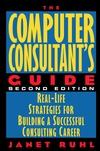

If you're considering becoming a consultant, or have been consulting for a while, The Computer Consultant's Guide can help you understand which skills and practices contribute to being successful

Author: Janet Ruhl
Publisher: John Wiley & Sons, Inc.
Price: $24.95 US
ISBN: 0-471-17649-4
Reviewer: Ralph Krause
Making a living as an independent computer consultant is not an easy task, and running a business requires skills that technical people might not be comfortable using. If you're considering becoming a consultant, or have been consulting for a while, The Computer Consultant's Guide can help you understand which skills and practices contribute to being successful.
Written by Janet Ruhl, a leader of CompuServe's Computer Consultant's Forum and a regular contributor to “Contract Professional”, this edition of the book has been updated and now includes information on consulting in Canada and Europe. The book contains 290 pages divided into eleven chapters, appendices and an index.
Subtitled “Real-Life Strategies for Building a Successful Consulting Career”, The Computer Consultant's Guide covers all phases of a consulting career from determining if you're ready to start consulting through increasing your business once you are successful. The book contains quotations from many consultants, which demonstrate real-life examples of the ideas presented.
The first chapter of the book provides a general explanation of what different computer consultants do. It covers contract programmers, resellers, custom application developers, multimedia/web authors and management consultants. For each type of consultant there is a “Meet the Consultant” section that contains thoughts from a consultant practicing in that field. The chapter ends by providing common questions and answers about computer consulting.
The next chapter helps you to determine if you are ready to begin a consulting career. It is important to examine both your skills and your pool of potential clients. It explains that finding the first client is usually easy, but that finding enough of them to make a living is difficult, so there is advice on how to build a pool of potential clients before striking out on your own. It also offers advice on personality and business skills that will help you to be a good consultant. Potential financial pitfalls, such as the loss of insurance and difficulty obtaining loans, are explained. The chapter ends with a discussion on preparing your family for your new job and contains specific information for mothers who are wondering if consulting will let them stay close to their children while earning a good income.
Chapters Three through Seven deal with the mechanics of running a consulting business. Covered topics include obtaining licenses, deciding if you need to incorporate, creating a business image, marketing your services and working with brokers. Most useful for beginners are the chapters on determining rates and successful marketing strategies. Chapter Five addresses the problem of determining what to charge and helps you decide if you should ever work for nothing. Chapter Six covers marketing and stresses that word of mouth is your best type of marketing. It does offer advice on mass mailings, brochures, advertising and cold-calling if you feel that you must try these. Chapter Seven gives advice on working through brokers, especially on how to find a reputable one and how to avoid Draconian noncompetition clauses that can prevent you from working with old clients once you leave the broker.
The next three chapters cover client relations—from interviews with potential clients through collecting payments. Chapter Eight helps you conduct an interview with a potential client, determine when to start charging them and explains common contract clauses of which to be wary. Chapter Nine concerns consultant behavior while working for a client and includes advice on dealing with common problems, both technical and personal, encountered at a client's site. Chapter Ten deals with support and payment issues. It shows how support for old clients can be profitable and provides advice on how to support them without slighting new clients. It also discusses what to do if clients are slow to pay, won't pay or can't pay.
The final chapter business, dealing with success and avoiding burnout. If you have more work than you can handle this chapter helps you decide between hiring more employees to handle the load or taking on less work. If your business has plateaued, it explains how you can increase business by doing such things as selling hardware, giving seminars and/or writing. It also helps you avoid getting in a rut from doing the same type of work year after year. There are times when leaving consulting and reentering the corporate world will appeal to you, and this chapter helps you determine when to do this and provides information on doing it gracefully.
The book contains two appendices and an index. Appendix A is a list of resources for consultants, including print material, professional organizations and web sites. Appendix B lists the twenty factors that the IRS uses to establish your status as either a contractor (consultant) or an employee for clients.
The book is easy to read, and Ruhl's extensive experience in dealing with these issues is apparent. This book was published in 1997, but it is not outdated because it focuses on business skills, not technical ones.
The Computer Consultant's Guide provides easy to understand, practical information for consultants just starting out or for people considering entering the field. If you've tried consulting previously but were unsuccessful, it can help you determine what went wrong. In addition to helping you determine when you're ready to start consulting, it can also help you avoid common consulting pitfalls and keep your business growing.